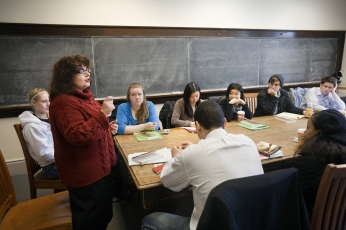COVER STORY
In the humanities, classrooms are labs and students are collaborators
(Page 4 of 4)Associate professor of classics and Milstein scholar Verity Platt finds it very helpful to do close analysis of primary material with a group. It enables her to get to know the material in a much deeper way, which can serve as a springboard for new approaches. One class on painting she taught sparked so many ideas for articles that she's now planning a book to incorporate them all.
Although Platt recalls a few times when students have wanted to work directly on her research topic, the question of intellectual property hasn't really been a problem. "I always try to live by the principle that you need to be generous with ideas," she says. "Any intelligent, good academic has enough ideas to not be overly protective of things."
Trial run
Raskolnikov perches on the edge of the desk, looking out at the semicircle of students. It's the first class after spring break, and some of the students seem still to be recovering from their time off. One young woman in particular leans sleepily on her hand.

Raskolnikov facilitates a class discussion during her "Apologizing Well" freshman writing seminar in Goldwin Smith Hall in spring 2011. See larger image
It's a perfect opportunity for Raskolnikov to test her ideas. The sleepy woman is a bright student who can be counted on to make a comment whenever the material is particularly interesting. As she presents her new ideas, Raskolnikov watches the woman closely. When the sleepy student snaps to attention, Raskolnikov knows she has hit it right.
"You can just see from the way they're sitting when it works and when it doesn't work," says Raskolnikov. "When they're tuned in and really with you because you're right, you can feel them sort of vibrate at different frequencies."
Philosophy professor Bennett would no doubt agree. She often finds herself hurrying back to her office after a graduate seminar to take notes, because she's realized that "some argument I was trying to run just doesn't fly, or the way to do it is to go this other direction," she says.
Lightning strikes
Lightning struck for German studies professor McBride when she and her class were working on montages that merged object and text by combining visual elements. They were examining a work by a Dadaist (an adherent of an early 20th century absurdist movement), when a student suddenly pointed out that part of the image formed a word McBride had never noticed. "The student was able to define something that opened up a whole different reading of this image. This is what makes teaching so thrilling," she says.
Fundamentally, says Ivan Salinas '14, "the humanities is not a try and fail environment, it's more of an open-minded, critical environment that helps teachers with their research and students with their critical thinking.
"The things we learn in humanities classes stay with you for the rest of your life. In 30 years I might forget the quantity of an astronomical unit, but I will never forget what it means to apologize well."
Linda B. Glaser is a staff writer for the College of Arts and Sciences.
- View entire story as one page -